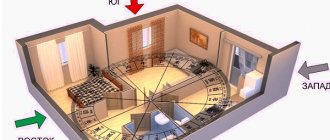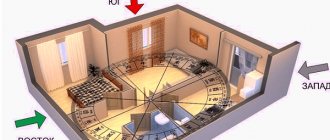Linguistic anthropological studies have shown that most human societies had four points of cardinal direction. The names given to these directions were usually derived from either locally defined geographical objects (e.g., "towards the hills", "towards the sea"), celestial bodies (especially the sun), or atmospheric objects (winds).
According to the chronicler Reinhard (c. 830), the Frankish king Charlemagne coined his own names for the classical winds. He named the four cardinal winds as:
- Nord (etymology uncertain, maybe “wet”).
- Ost (shining place, sunrise).
- Court (solar lands).
- Vest (habitat, meaning evening).
The intermediate winds were constructed as simple composite names of these four. These names are the sources of modern names for compass points, found in almost all modern Western European languages. For example, north, east, south and west in English: Nord, Est, Sud, Ouest.
North, south, west, east: location
The locations of north, east, south and west are called cardinal directions or cardinal points, and are usually designated by the letters, N, E, S, W. East and respectively west are located at right angles to north and south, and east is on a clockwise rotation vector arrow from the north and west directly opposite the east. The points between the directions form compass points. Intermediate (intercardinal or ordinal) directions are northeast, southeast, southwest and northwest. The intermediate direction of each set between the cardinal and cardinal directions is called the secondary - intercardinal direction, which is denoted by:
- NNE.
- ENE.
- ESE, etc.
How to determine feng shui zones in an apartment
As you probably already know, Feng Shui is the science of the proper organization of space... Today we’ll talk about how to organize this very space in a room. So, how to determine Feng Shui zones in an apartment and what is needed for this?
What is needed to define zones?
Firstly, in order to properly organize your space indoors (in an apartment, in a house, in an office, etc.), you need to decide for yourself what area of life you would like to change. For example, move up the career ladder, meet love, etc.
Secondly, when you have decided on the sphere of life, you need to find out where in the house the direction responsible for this sphere is located. Most often in Feng Shui such directions are called sectors or zones.
What feng shui zones exist in an apartment (house)?
According to Feng Shui, there are only 9 zones. Each of them is responsible for one or another aspect of a person’s life and is located in the corresponding direction of the world.
In order not to upset the balance of energies in the house, it is best to activate not one zone, but several. I’m not saying that it’s all 9 at once. Of course not! This will be a clear overkill. Somewhere around 3 zones will be enough (or a little more, it’s up to you). The main thing is to observe the basic principle of Feng Shui - harmony in everything. So that everything fits perfectly, looks beautiful and natural.
According to Feng Shui, all nine aspects of life are interconnected with each other and are combined into the Bagua grid (or there is also the Loshu square).
The Bagua grid is an octagon, each side of which corresponds to a trigram (Bagua is literally translated as “ba” - eight, “gua” - trigram, “ba-gua” - eight trigrams), a cardinal direction, a certain color and one of the five Elements ( Tree, Earth, etc.).
How to determine the feng shui zones in an apartment correctly?
In order to determine where the zones are in an apartment (house) according to Feng Shui, arm yourself with a compass, a floor plan and a Bagua grid (or a Loshu square).
As for the compass, I’ll make a reservation right away. In general, Feng Shui masters use the Lopan compass to determine zones in an apartment. This is a professional compass for a Feng Shui consultant, and not cheap. It consists of a square base, a rotating disk and a magnetized pointer. Lopan has rings on it, inside of which are drawn hieroglyphs and numbers that make up various Feng Shui formulas. Of course, this is a good thing, but for a novice fengshuist or a simple layman, it will be enough to use an ordinary engineering compass.
You can draw the floor plan yourself, or take it from the BTI documents. Only if you do it yourself, draw a plan of the apartment with all the actually existing premises. Don't forget about the bathroom, toilet and storage room.
You can take a Bagua grid or square from the Internet or directly from this article. Just click on the image, it will enlarge, then right click - save as. And print it out.
Now that we have all the tools for determining the Feng Shui zones in the apartment ready, let’s begin the task.
Feng Shui compass – Lopan
Using a compass we determine where north is. Its arrow always points in this direction. When you have found the north, mark it on the apartment plan. Then take the Bagua grid (or the Loshu square) and attach it to the apartment diagram so that north coincides with north. And then, following the markings on Bagua, you can easily find the remaining sectors. As you can see, this is not at all difficult.
A little advice for those who don't have a compass: you can orient yourself to the east. As you know, in the east it rises in the east and sets in the west. Therefore, remember from which side of your apartment or house the sun rises, through which window at dawn the first rays fall - that’s where the east will be. Accordingly, in this direction, attach the Bagua grid to the apartment plan with the same eastern trigram. Next, using the markings, you will determine the remaining Feng Shui zones in your apartment.
So, friends, let's summarize.
Today we talked about:
* what feng shui zones exist?
* in what compass directions are they located?
* what is needed to determine feng shui zones
* how to correctly determine the feng shui zones in an apartment
I hope that the information given will be useful to you, and you will be able to correctly adjust some aspects of your life. Read more about each zone and how to activate them correctly in the following articles.
And finally. Dear readers, if you liked the article, I will be very grateful if you say a kind of “Thank you” by clicking on the social buttons and share interesting information with your friends and acquaintances. Your opinion is important to me and I always enjoy reading your comments on my articles. Leave feedback and this will help make the site even more interesting and useful.
Sun
The position of the Sun in the sky can be used for orientation if the general time of day is known. In the morning the sun rises approximately in the east. In the evening the sun sets approximately in the west. At midday, it is in the south for Northern Hemisphere viewers who live north of the Tropic of Cancer, and in the north for Southern Hemisphere viewers who live south of the Tropic of Capricorn. This method does not work very well when the observer is closer to the equator (i.e. Between the Tropic of Cancer and the Tropic of Capricorn).
Due to the axial tilt of the Earth, regardless of the viewer's location, there are only two days each year when the sun rises due east. These are the days of the equinox. On all other days, depending on the time of year, the sun rises either north or south of true east and falls north or south of true west.
Find a church
Another option to get to the bottom of where the horizon goes is to the west, east... It’s not always exactly correct, but as an auxiliary guide it can complement the picture.
So, if you are in a village or an abandoned village, perhaps you will find a temple there, or rather a church. You need to know that in Orthodox churches the altar will most often face the east. The bell tower will be facing west.
Christian churches are generally aligned from west to east, with the altar at the eastern end of the temple facing the sunrise. Headstones in cemeteries are also usually aligned from west to east.
Astronomy
Astronomy provides a method for finding direction at night. All stars lie on an imaginary celestial sphere . Due to the rotation of the Earth, the celestial sphere rotates around an axis passing through the Earth. This axis intersects the celestial sphere at the north and south poles of the celestial zone, which, according to the observer, lie directly above the north and south, respectively, on the horizon.
In either hemisphere, observations of the night sky show that visible stars move in circular paths caused by the Earth's rotation. This is best seen in long exposure photography. The resulting photograph shows many concentric arcs (parts of perfect circles) from which the exact center can be easily obtained. This center corresponds to the celestial pole, which lies directly above the position of the true pole on the horizon.
The north celestial pole is currently (but not always) within 1 degree of the star called Polaris. The exact position of the pole changes over thousands of years due to the precession of the equinoxes. The North Star is visible only on cloudless nights for residents of the Northern Hemisphere.
While observers in the Northern Hemisphere can use Polaris to locate the North Celestial Pole, the southern star of the constellation Octantus is barely visible to use for navigation. For this reason, the preferred alternative is to use the Southern Cross constellation.
Determining the cardinal directions by the North Star
North, South, West, East, whose location needs to be found at night, are clearly shown by night lights. At night, the location of the true meridian can be determined using the North Star.
It always points to the geographic North and is part of the constellation Ursa Minor. To determine its location, you first need to find the constellation Ursa Major.
It is represented by 7 bright stars, which in the sky form a figure in the form of a ladle with a handle. Having found the two extreme stars of the bucket itself (not its handles, but the container), mentally draw a straight line through them. At the top of the line, approximately five times the distance from these stars, there is a very bright star, which is called Polaris.
To make sure that this is the star you are looking for, you need to find the constellation in which it is located (Ursa Minor). This is exactly the same bucket, only smaller in size and turned in the opposite direction, relative to the Big Dipper. Determining coordinates using the North Star is quite accurate, deviations are only 1-1°.
Gyro-compass
At the very end of the 19th century, in response to the development of battleships with large transverse guns that acted on magnetic compasses, and perhaps to avoid the need to wait for good weather at night. In order to accurately check its alignment with true north, a gyrocompass was developed . Because it finds true poles rather than magnetic ones, it is immune to interference from magnetic fields.
Its main drawback is that it relies on technology that many people may find too expensive to be worthwhile outside the context of a large commercial or military operation.
Determining cardinal directions using a watch
This method of orientation is based on the exclusive property of the Sun - to indicate the direction of the South at 13 o'clock. At other times of daylight, you can set the direction of the cardinal directions using a wristwatch with an arrow dial.
To do this you need:
- Place the watch in your hand in a horizontal position.
- Turn them so that the hand showing the clock points to the Sun.
- Mentally draw the bisector of the angle formed between the hour hand and the direction in which the number 1 is located. It will indicate the southern direction.
- The correctness of this determination method depends on the position of the Sun relative to the horizon. The higher it is, the greater the probability of error (it can reach 10°). In southern latitudes, due to the high position of the Sun, this method of orientation is not suitable.
Satellite navigation
At the end of the 20th century, the advent of satellite global positioning systems provided another means of accurately determining true north. Government agencies in charge of satellites constantly monitor and adjust them to maintain their precise alignment with the Earth.
Unlike a gyrocompass, which is most accurate when stationary, a GPS receiver, if it has only one antenna, must move, usually at speeds greater than 0.2 km/h, to correctly display compass directions. On ships and aircraft, receivers are often equipped with two or more antennas separately attached to the vehicle.
Do compasses on smartphones generally show the direction correctly?
In fact, I don’t know a single person who would go mushroom hunting with a smartphone with a compass turned on. Normal people always take a real device with them, and those who know, in addition, take with them a map of the area, matches, a knife and a fully charged phone (in order to call and call rescuers in case of problems, if Network coverage allows).
So, if maps via GPS actually show locations with an accuracy of several meters, then there is a problem with the operation of electronic compasses. Here is an example of how compasses work on two Apple devices: iPhone 6 and iPhone 7:
And who to believe? The settings for both are set to “True North”, yes, the measurements were taken in a room where interference from electronic devices, plus reinforcement and a layer of concrete, has a significant influence, but still the difference on the devices is obvious. The most interesting thing is that the discrepancy with magnetic north on a real compass is from 60 to 120 degrees for both devices.
In general, I honestly wouldn't rely on phone readings in the field. Moreover, this “compass” drains the battery very quickly. A toy, nothing more.
Use of cardinal points for making maps
Thus, with the cardinal points precisely defined, by convention cartographers draw standard maps with north (N) at the top and east (E) at the right . In turn, maps provide a systematic means of recording places, and cardinal directions provide the basis for a structure for locating those places.
In the real world there are six cardinal directions not related to geography, which are north, south, east, west, up and down. In this context, up and down refer to height, or perhaps depth (if water is involved). A topographic map is a special case of cartography in which elevation is indicated on the map, usually through contour lines.
How to calculate cardinal directions without a compass, smartphone and map?
Now that we all have GPS and Google Maps with Yandex.Maps on our phones, which are always with us and ready to serve us at any moment, we have already forgotten many useful techniques that we were taught back in school during geography lessons and which they helped us navigate space so well in any conditions, without maps, without compasses and, of course, without these same smartphones.
And okay, we, those who managed to enjoy a non-synthetic life without the influence of smart phones, all kinds of electronic assistants and all kinds of electronic devices, but the new generation born in the early 2000s and later, unfortunately, did not come into contact with those rules of the game , which were used before the Apple electronic revolution. But even though they were more complex, they could perfectly develop logic and ingenuity in a person, teach intelligence and help in difficult times. Because they were really useful...
But sometimes without knowledge and without your favorite smartphone you simply cannot survive! For example, you are walking in the forest, winter. At some point, you lose sight of the trodden path and realize that you are lost. It doesn’t matter, you reason, and, taking your phone out of your pocket, you try to enter the “maps” application. And suddenly... you realize that your phone is not working. From the word “in general”! The battery is low. What will you do to get your bearings, to find where north, south, west and east are?
Okay, let's not even take such an extreme example, let's say you're just curious about which cardinal directions are located? You cannot pick up a smartphone. Maps and compasses too. What will you do? We will tell you how to act correctly in such a situation.
Here are some strategies that will point you in the right direction, and you will find it solely through your knowledge and not through assistive devices.
Origin of ancient names
During the invasion of the Huns, names from Germanic languages for cardinal directions entered the Romance languages, where they replaced Latin names. Some northerners used Germanic names for intermediate destinations.
In many regions of the world, prevailing winds change direction seasonally, and so many cultures associate specific winds with cardinal and intercardinal directions. For example, classical Greek culture characterized these winds as Anemoi.
In post-medieval Europe, cardinal and intercardinal movements were given names. These often corresponded to the directional winds of the Mediterranean (for example, the southeast was associated with the Sirocco, a wind from the Sahara).
Determination of cardinal directions using radio signals
Experienced travelers take into account the possible risks associated with the hike and try to protect themselves as much as possible. Even before the start of the route, they find out the presence of radio stations and radio beacons in the area, and take their azimuths.
Ideally, if at least one of these structures points to one of the cardinal directions. The kit with uniforms and provisions includes a receiver that receives long and medium waves.
If you lose your orientation, you need to turn on the radio and tune it to the long or medium wave range. While rotating around its axis, set the position to the worst sound and slowly turn until it disappears completely.
At the moment the sound disappears, the end of the radio receiver will be directed towards the transmitting radio station. If it is tied to one of the cardinal directions, then determining the correct trajectory of movement is not difficult. It is necessary to move towards the azimuth calculated in this way.
How to find out which side the windows face
Online compass to determine cardinal directions in an apartment
One of the basic principles of the Taoist practice of space exploration, known as “Feng Shui,” is the correct location of your home, as well as the interior inside it, relative to parts of the world. Where is your bed and other pieces of furniture, how is a person positioned while sleeping, where are the flowers, which way do the doors open, and so on. All this, according to Feng Shui, is important for our lives, contributing or hindering our happiness and prosperity. But how can you determine where your apartment is north and where it is south if you don’t have a standard compass at hand? In this article I will tell you how to determine the cardinal directions in an apartment and use a compass online, and what tools will help us with this.
We are learning how to determine the cardinal directions in an apartment
Method number 1. Using the compass online
To determine the location of your apartment relative to the cardinal directions, and also to understand where the windows of your room face, you can use the online map from Google below.
This map with cardinal directions works correctly with the Google Chrome browser and other browsers based on the Chromium core, but when working with Firerox the resource has problems.
The operating principle of this service is as follows. There is a large compass on the screen, you just need to find your city on the map, and then your house, and in accordance with the compass image (N - north, S - south, W - west, E - east) see which side of the world you are facing the windows of your home are directed. Then, in relation to this, you can understand how correctly you are sleeping.
Feng Shui believes that if your head is positioned on:
- North - this helps the development of intuition,
- Northeast - will help in scientific activities,
- East - guarantees a restful sleep,
- Southeast - will help in developing determination,
- South - will give fame and reputation,
- Southwest - will give help in Love,
- West - bestows fertility,
- North-west - will ensure true friendship.
The position of the human body during sleep according to Feng Shui is very important
Method number 2. Ask your neighbors where north and south are
If you have moved into your home recently, then neighbors who have lived nearby for a long time may well know where each part of the world is located relative to your home.
Neighbors living nearby can tell you where your house is located relative to parts of the world
Method No. 3. Watch the sunrise and sunset
As you know, our star rises in the east and sets in the west. Therefore, if you stand in such a way that your right hand points to the place where the sun rises (to the east), and your left hand points to the place where the sun sets (to the west), then north will be in front of you, and south behind you. And no online compass is needed to determine the direction of the world in an apartment.
Watch where the sun rises and where it sets
Method number 4. Use a regular needle to determine the part of the world in the apartment
This method involves using a regular magnetized needle instead of an online compass. To do this, you will need NOT a metal bowl with water (or oil), or some kind of floating material (for example, a piece of wood, polystyrene foam, a piece of bark, etc.). And also a pre-magnetized ordinary small needle (instead of a standard magnet, you can use ordinary scissors with which you can magnetize the needle). Place a buoyant material (for example, a leaf) on the liquid in the vessel, and then place a magnetized needle on this buoyant material.
Method No. 5. We use mobile applications
For mobile gadgets, there are a sufficient number of applications that demonstrate a digital semblance of a compass on user smartphones and can set part of the light in your home. This can be “Compass 360 Pro Free” (Android), “Compass” (Android), “Compass” (iTunes), “Free HD Compass” (iTunes) and other analogues. This mechanism works due to the magnetometer, accelerometer, gyroscope and GPS navigator built into the phone, allowing you to fairly correctly display the location of parts of the world.
The Compass 360 Pro Free mobile application will show you the location of parts of the world
Method number 6. Use a regular watch
If the day is sunny and the sun is shining through your window, then point the hour hand of the clock towards the sun. Now if you divide the angle between 12 o'clock and the hour hand in half, then the resulting middle will point south.
Determine where south is using a clock
Conclusion
In this material, I described several ways to determine the cardinal directions in an apartment, as well as the features of working with an online compass. If you need to quickly determine parts of the world, I recommend using the capabilities of this compass, or installing one of the mobile applications I listed. They will allow you to quickly track the location of the cardinal directions in your apartment.
Online compass - determine the cardinal directions in the apartment
What to do if you don’t have a real compass at hand, but you need to determine the cardinal directions? It doesn’t matter, you can do it online: on your computer or in a mobile application.
How to determine cardinal directions from a computer using Google Maps
Despite the fact that the monitor does not rotate, and the north is always at the top, you can still navigate by cardinal directions in Google Maps.
First, find your location. For this:
You will see a view of the area from above, which you need to somehow navigate.
Remember that north is now at the top of the map. It would seem that this is enough.
But looking at the area from above, many find it difficult to find the side where their windows face. Panoramas will help simplify this task. To open a panorama:
- Click on the yellow man.
- Blue lines will appear - these are the places you can click to open the panorama. These places were driven around by Google car and photographed.
A 3D picture that is already familiar to the human eye will open, in which you can move. And it has a compass!
It’s easier to navigate in this picture. For example, I see that my windows look to the right - towards the road. Which side of the world this is can be seen by the compass arrow on the right side of the screen. It is directed with the red end to the right and slightly upward. That means north and a little up. How to determine whether it is east or west (above)? Easily. Just imagine that you are facing north. Then the east will be on the right hand, and the west will be on the left. Thus, the arrow is directed to the northwest. This means that the windows face northeast - this is the direction perpendicular to the road from left to right.
table style=”width: 100%,” border=”0″ cellspacing=”1″ cellpadding=”1″>
Looking for suitable designs? Ready-made solutions, decor and photos of home furniture.
Everything about planning, designing the design, interior and comfort of your home and furniture on the website: ArtPro100.Ru
Similarly, you can determine the sides on Yandex.Maps, only there is no compass arrow, but there are panoramas.
What kind of ceiling should I make in the kitchen?
What ceilings are trending in 2021?
So, meet the stretch ceiling trends of 2021!
- Stretch ceilings in metal, mirror, concrete, wood shades.
- Stretch ceilings with track lights.
- Light lines of different shapes.
- Soaring ceilings with a line of light along the perimeter.
- Ceiling using shadow euro profile.
- Double Vision technology
What kind of ceiling should there be in the kitchen?
Glossy ceiling is the most popular option, and is simply ideal for the kitchen. It gives a slight mirror effect, visually enlarges the space, and is easy to clean. A matte ceiling with a slight texture looks like whitewash. Satin is the “golden mean” between matte and glossy surfaces.
How can you decorate the ceiling in a kitchen in a private house?
Inexpensive ceiling design options include painting or whitewashing, foam tiles, gypsum stucco, decorative plaster, and wallpaper.
Which ceiling should I make in the kitchen, matte or glossy?
Matte The main advantage over glossy ceilings (besides the cost - matte ceilings are cheaper than glossy ones) is ease of maintenance. Matte ceilings do not attract dust, no stains are visible on them, and caring for them is as simple as possible.
What types of ceilings are there?
- Plasterboard ceilings
- Cassette ceilings
- Mirror ceilings
- False ceilings
- Slat ceilings
- Stretch ceiling
How can you cover the ceiling in the kitchen?
Types of ceiling decoration in the kitchen:
- wallpaper;
- plastering and painting;
- plastic;
- expanded polystyrene panels;
- suspended ceiling;
- plasterboard ceiling;
- MDF panels.
How to decorate the walls and ceiling in the kitchen?
The best options for the kitchen may be:
- Non-woven wallpaper This type of wall transformation allows you to get a surface that is not afraid of grease, soot and fumes, is easy to clean and lasts a long time. ...
- Paintable wallpaper...
- Liquid wallpaper …
- Vinyl...
- Plastic...
- MDF
Which is better to make a ceiling in a private house?
Which ceiling is better to make in a private house?
- Tension fabric
- Plasterboard blocks
- Ceiling using wooden blocks or beams
- Plaster
- Cassette ceilings
- Wallpapering
What is the best ceiling for a small kitchen?
* For the ceiling of a small kitchen, designers recommend using the following colors: white, light beige, milky, creamy, light gray, light golden, soft turquoise, light purple and other tones from the light range of the color palette. * Plasterboard ceilings do not need to be painted in very dark and gloomy colors.
How can you decorate the ceiling inexpensively?
1 Cheap, beautiful, long lasting - what’s the best way to decorate the ceiling? 2 Whitewash or paint 3 Wallpaper 4 Ceiling tiles ... The most popular options are:
- whitewashing, painting;
- wallpapering;
- applying liquid wallpaper;
- gluing tiles;
- hanging structures;
- stretch fabrics.
What to do if the ceiling is low?
To make the ceiling in a low room visually higher, use these design tricks:
- bet on white. ...
- gloss and shine. ...
- blue shades for the ceiling. ...
- the ceiling should be lighter than the walls. ...
- ceiling and walls in the same color. ...
- box and moldings. ...
- vertical stripes are another win-win way to raise the ceiling.
What can be done with the ceiling in a private house?
The main materials that craftsmen use to realize design fantasies on ceilings are:
- Drywall. Ideal if the ceiling is uneven or has other defects. ...
- Stretch ceiling. ...
- An economical option for a private home is panel coverings. ...
- Another inexpensive option is installing ceiling tiles.
Which suspended ceilings to choose for the kitchen?
Stretch matte ceilings softly diffuse light and do not create glare. Matte stretch ceiling fits perfectly into any kitchen interior. Stretch satin ceilings are very similar to matte ones, but they reflect light, so the kitchen seems larger than it is. They fit perfectly into the interior of any kitchen.











